By Brent McGhie, Butte County Master Gardener, February 7, 2014
Since this is shaping up to be one of the driest years in California history, it's appropriate to look at ways to conserve water in the home garden. A good starting point is the garden soil itself. Sandy soils tend to drain too rapidly, while heavier clay soils may drain poorly and not provide sufficient oxygen for plant roots. Adding organic compost to the soil will help rectify both of these situations. Organic material increases the water-holding ability of sandy soils and loosens clay soils, so that they are better aerated.
A lawn is normally the single greatest water-user in the home landscape, so unless it serves a specific purpose, such as entertainment, or a play area for pets or children, you might consider replacing it. Lawn substitutes can include planters, ground covers, mulches or hardscape features such as decks or patios. If you choose to have a lawn, the type of turf will affect water use. Warm season grasses such as Bermuda grass, St. Augustine grass, or zoysia grass typically require about 20 percent less water than cool season grasses like tall fescues or bluegrass. Water only when necessary. If you step on the lawn and it springs back when you move your foot, it doesn't need water. Aerating the lawn will maximize water penetration and the duration of watering should be timed so that excess water does not run off of the lawn due to saturated soil. Adjust sprinklers so that water does not end up on concrete or gutters where it is wasted. For lawns and all landscape plants, watering in the early morning hours when wind and temperatures tend to be low means less water will be lost to evaporation.
If you are deciding what to plant, California natives from our climate zone are a good choice. They will need regular watering at first, but can often survive with little more water than they receive from average rainfall after they are established. Try to limit the use of plants that require frequent irrigation and, for efficiency, group them in areas where they can be watered together.
All plants should be watered only when necessary. Check on soil moisture and adjust your watering schedule frequently to reflect seasonal variations in temperature, wind and rainfall. Any plants with similar watering requirements should be grouped and watered with separate valves. Although sprinklers are the best way to water lawns, the most efficient way to water other plants is with drip or soaker hoses. This minimizes water loss through evaporation or runoff. Infrequent, deep watering results in deeper root growth, which in turn allows plants to develop greater tolerance for hot, dry weather. It is important to maintain your irrigation system, checking for leaks, broken sprinkler heads, clogged drip emitters and other problems that could result in wasted water or stressed plants.

A drought year is not the time to engage in excessive pruning. Such pruning can lead to heavy plant growth and a resulting increased demand for water. Light pruning during the winter can shape a plant without stimulating excess growth. And early summer pruning reduces vigor, leaf area and water demand without stimulating excessive growth.
Over-fertilizing can also result in excess plant growth and extra water consumption.
There are several advantages to mowing lawns slightly higher during hot weather. Their growth rate is slowed (reducing water demand) and deeper root growth is encouraged. Taller grass also shades the soil, which lowers evaporation and reduces weed seed germination.
Finally, think twice before running water. Indoors, for example, flush the toilet only when necessary. Turn off the tap while brushing your teeth. Capture water in a bucket or a large pot while the shower or the dishwater is warming up and use it to water garden plants. Using a broom instead of the hose to clean a driveway can save hundreds of gallons of water. Leaving the hose running while washing a car can waste 150 gallons of water; instead, re-fill a bucket with water as needed, and turn off the hose. It's often just a matter of common sense.
Geisel, Pamela M. "Pub. 8036 Water Conservation Tips for the Home Lawn and Garden." Anrcatalog.ucdavis.edu. UCANR, n.d. Web. http://anrcatalog.ucdavis.edu/pdf/8036.pdf
"Water Conservation in Your Garden & Landscape Checklist." Colusa County Farm Bureau. UCCE, n.d. Web. http://cecolusa.ucanr.edu/files/65442.pdf
Kim, Dohee. "Questions and Answers about Water Conservation." UC Cooperative Extension Connection. UCANR, n.d. Web. //ucanr.edu/blogs/blogcore/postdetail.cfm?postnum=5356
Water Conservation Suggestions for Your Home Vegetable Garden." UCCE Master Gardeners of Trinity County, n.d. Web. http://cetrinity.ucanr.edu/files/180197.pdf
